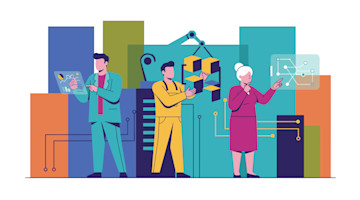Europe’s automotive sector has long been the main industrial contributor to European prosperity. In recent years it has suffered a significant setback but also began a profound electrification transformation. Nevertheless, it remains a prime mover of the manufacturing economy, and its developments are of fundamental importance for the overall manufacturing landscape.
Although EU investment in automotive R&D decreased in 2020, Europe remains the world's largest investor in innovation in the auto industry at its present level of over $60 billion per year, surpassing Japan ($33 billion), the United States ($15.5 billion), and China (over $10 billion).
However, even more significant investment is required from carmakers as they upgrade their manufacturing sites in preparation for an electrified Europe – and the regulations that spell the end of new, internal combustion engine car sales in the EU by 2035. Ambitious electrification targets affect Europe’s climate strategies, including zero tailpipe emissions, as well as carbon reduction or complete neutrality goals. In order to meet and finance these targets, carmakers will need to make substantial EV sales.
This applies across the industry. Volvo and Jaguar Land Rover are reimaging their lineups. Mercedes-Benz, BMW, and Audi are in their own race to get to the EV future; Germany’s Ford has trimmed its gas-powered lineup in favor of EVs; and even Swedish Polestar has successfully marketed its first EV crossover. Companies like Aston Martin, Maserati, and McLaren play their own EV game. At the same time, Korean manufacturers in Europe have been releasing one EV model after another. Toyota has been eyeing investments in European EV trucks.
Three European carmakers that have just made significant announcements on their EV strategies are Mercedes-Benz, Volvo, and Stellantis. In order to comply with the upcoming EU regulations as well as retain their overall profitability, these companies are scaling up EV production.
Mercedes-Benz is now focusing on higher-priced luxury vehicles to drive profits. The manufacturer plans to upgrade its product portfolio and drop cheaper models as it prepares to go all-electric by 2030, at least where market conditions allow, and aims to halve carbon dioxide emissions per passenger car by the end of the decade. It is investing more than $ 2 billion in European production sites. Three German plants in Sindelfingen, Bremen, and Rastatt, and one Hungarian site in Kecskemet, will start production of new models in the top-end luxury, core luxury, and entry-luxury segments from 2025 on. Moreover, Mercedes-Benz is increasing its EV battery production locally, claiming that its close proximity is a key factor in the success of its electrification strategy.
Volvo is one of the most outspoken carmakers regarding EV production. The Swedish manufacturer will go all-electric by 2030 – and unlike Mercedes-Benz, there will be no exceptions. Volvo will build its third European manufacturing site in Slovakia for electric cars exclusively with an investment of $ 1.2 billion. The plant will be climate-neutral, complementing Volvo’s other European sites in Belgium (Ghent) and Sweden (Torslanda). The three locations can produce 600,000 cars annually, supporting Volvo’s broader annual sales targets. By 2025, the Swedish manufacturer intends to sell 1.2 million vehicles annually.
Stellantis is striving to reach a 100% passenger-car battery-electric vehicle (BEV) sales mix in Europe within the next few years. Since 2018 it has spent more than $2 billion on its French manufacturing sites, helping to transform key production plants there. The Tremery-Metz facilities have already upgraded powertrain manufacturing for BEVs and hybrids. The company is focused on producing electrified dual-clutch transmissions and expects to grow its annual production capacity of such gearboxes to 600,000 by 2024. On a global scale, Stellantis has created a new global value chain, including five Giga factories, to support its “Dare Forward 2030” targets.
Other U.S. companies are also creating strategies for Europe apart from well-established Ford. Everyone knows about the ups and downs of Tesla in Germany. U.S.-based Rivian has been planning to open a European electric adventure factory since early 2021. The company considered a German location, but facing the reality of the continent's most expensive economy, it is now looking for alternatives. Its CEO is sometimes called the anti-Elon Musk, so a similar Tesla strategy is unlikely. Lucid Group, which manufactures the fastest-charging EV with the most extended range in the North American market, has entered the Netherlands and Germany and is further expanding its European sales. There are predictions that Lucid CEO Peter Rawlinson, formerly with Tesla, is completing a study for the European Lucid Air Dream factory location.
Automotive is an essential contributor to the transportation infrastructure of Europe. Sustainable transportation is part of the “Connecting Europe Facility” project, under which the expenditure of over $5.5 billion is already underway. Selected projects support all forms of the “Trans-European Transport Network,” the system of roads, railways, inland waterways, short-sea shipping routes, ports, and airports that will link the EU’s member states and beyond, and the infrastructure that will help the EU meet its climate objectives as set out in the European Green Deal. The ensuing demand for EV road transport vehicles is markedly on the increase.





